Why you can trust Tom's Hardware
AMD Ryzen 7 5700G Integrated GPU Gaming Performance — The TLDR
Below you can see the geometric mean of our integrated graphics gaming tests across five titles at 1280x720 and 1080p, with each resolution split into its own chart to give us a decent overall view of the current landscape. These are cumulative metrics, so individual wins vary on a per-title basis. You'll find the game-by-game test results further below, and then some dedicated tests that compare the Ryzen 7 5700G directly to discrete GPUs.
Here are the Ryzen 7 5700G configurations for the entries in the charts below:
- Ryzen 7 5700G: 2x 8GB DDR4-3200 (dual channel) memory @ 16-16-16-36, ASRock Taichi X570, PBO disabled, Default power limits
- Ryzen 7 5700G PBO + DDR4-4000: 2x 8GB DDR4-3200 (dual channel) memory @ DDR4-4000 19-19-19-48, ASRock Taichi X570, PBO enabled, FCLK at 2000 MHz (1:1 coupled mode), RX Vega at 2400 MHz
- Ryzen 7 5700G HP Dual Channel: 2x 16GB DDR4-3200 (dual channel) memory @ 22-22-22-52, HP Pavilion TP01-2066, No configurable options
- Ryzen 7 5700G HP Single Channel: 1x 16GB DDR4-3200 (single channel) memory @ 22-22-22-52, HP Pavilion TP01-2066, No configurable options


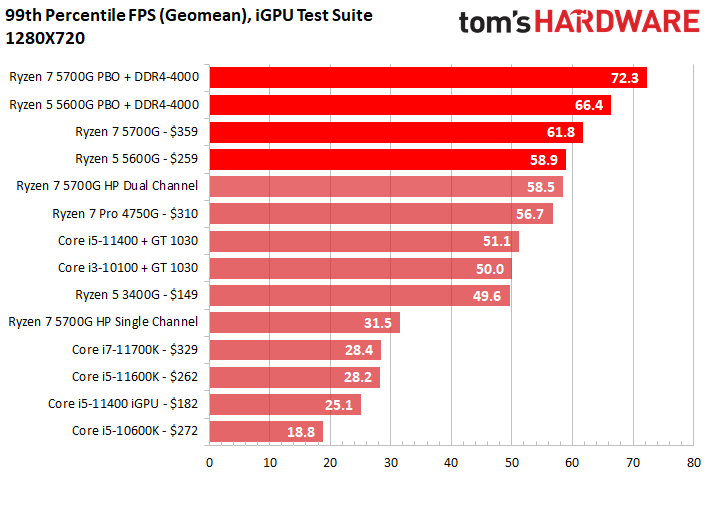

Our 1280x720 and 1080p cumulative results speak volumes about HP's decision to ship Ryzen 7 5700G-powered systems with a single stick of memory — the single-channel configuration delivers a devastating blow to performance. The dual-channel HP configuration is 74% faster at 1280x720 than the single-channel configuration, and 82% faster at 1080p. Bear in mind that the single-channel configuration is the only option available through Office Max, so plenty of uninformed customers are buying what are best described as crippled systems. Luckily we located a matching DIMM to test a dual-channel config with the same memory that's spec'd for the system.
We dropped the chip into the ASRock Taichi to see the difference between the HP system and an enthusiast rig, but the differences were surprisingly small. The X570 system was only ~4% faster at 1280x720 and 1080p, albeit against what we would consider a properly-kitted HP system with dual memory DIMMs. So naturally, an enthusiast motherboard will be a much better solution for any type of overclocking or even basic tuning (the HP system doesn't allow you to manipulate literally any setting), not to mention the far superior connectivity options and other enthusiast trimmings, like RGB bling.
| Row 0 - Cell 0 | 1280x720 | 1920x1080 |
| Ryzen 7 5700G B550-E | 100% | 100% |
| Ryzen 7 4750G | 92.9% | 94.1% |
| Ryzen 5 3400G | 83.5% | 84.1% |
| Intel UHD Graphics 750 32 EU (11600K, 11700K) | 58.3% | ~48.9% |
| Intel UHD Graphics 630 24 EU (10600K) | 36.0% | 34.4% |
The table above gives us a succinct iGPU performance comparison of the five most relevant chips, with the Ryzen 7 5700G on the ASRock motherboard used as the baseline. We see a pretty impressive ~10% performance improvement from the 3400G to the 4750G, but bear in mind we're looking at the jump from a quad-core to an eight-core chip. The move from Renoir (4750G) to Cezzane isn't quite as impressive at ~7%, but that's still a solid gain given that we're looking at fundamentally the same Radeon RX Vega engine paired with eight CPU cores.
The Intel chips give us about what we expect, which is roughly the same (or slightly less) performance than the crippled Ryzen 7 5700G with a single memory stick. Intel's UHD Graphics 750 engine with the Xe architecture marked a decent step forward over the company's UHD Graphics 630 engine, but Intel's decision to port the Xe architecture back to the 14nm process resulted in fewer graphics cores — the highest-end desktop chips currently have 32 EUs, whereas the 10nm Tiger Lake chips stretch up to 96 EU.
As such, the Core i7-11700K and Core i5-11600K pull up far short of what we would expect from a graphics engine that's intended for meaningful gaming, showing they're better suited for basic display functionality. The Intel chips struggle at both 1280x720 and 1080p, netting roughly half the performance of a properly configured Ryzen 7 5700G system.
Intel has made strides here, sure, just look at the improvement over the UHD Graphics 630 engine in the 10600K. But it still lags AMD's three-year-old Ryzen 5 3400G 'Picasso' chips. Alder Lake can't come soon enough, but it remains to be seen if any of the desktop models will come with enough EUs to put up a decent fight against AMD's potent APUs.
We also include tests systems equipped with the $182 Core i5-11400 and $122 Core i3-10100 paired with a GT 1030 as a point of reference. Given today's scalper pricing, the GT 1030 can be had for around $180 at retail, and if you can find the CPUs at MSRP, the ~$360 Core i5-11400 system would compete with the Ryzen 7 5700G, while the ~$300 Core i3-10100 system would kind of compete with the Ryzen 5 5600G.
Get Tom's Hardware's best news and in-depth reviews, straight to your inbox.
The Ryzen 5 5700G is the better buy here only if you don't plan on upgrading to a better graphics card in the future and you aren't willing to buy a used graphics card on the second-hand market (particularly a less expensive previous-gen model). If you plan on upgrading the GPU later, the Core i5-11400 is the better solution. Also, you can buy a used previous-gen graphics card with more horsepower than the GT 1030 and come out further ahead on gaming performance, but pricing will vary.
Overall, the results are clear; if you're looking for the best integrated graphics on the desktop, Cezanne is really the only game in town. As long as you adjust your expectations and fidelity/resolution settings accordingly, Cezanne is plenty serviceable for its target audience. We found 1280x720 gaming to be solid across numerous titles. While the number of titles you can play becomes extremely restricted at 1080p, you can get away with 1080p gaming with reduced fidelity settings in many titles, too. Overclocking yields huge benefits, too.
Far Cry 5 on AMD Ryzen 7 5700G


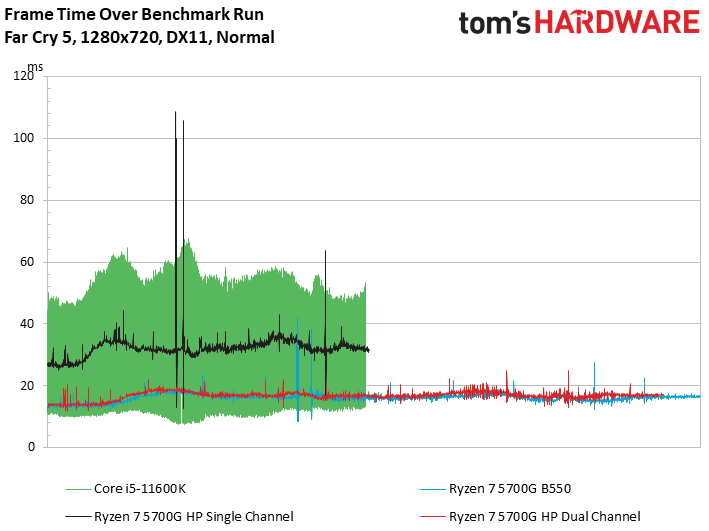

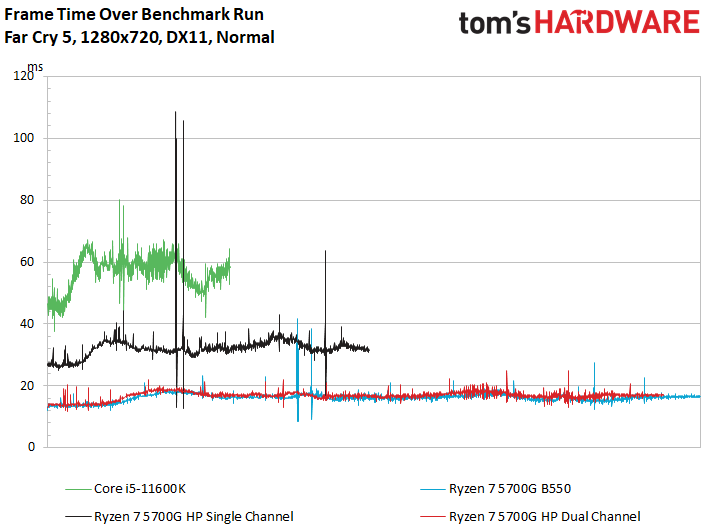

In terms of alternatives to the 5700G that you can actually buy, you're looking at the Core i7-11700K and Core i5-11600K. However, the Intel processors absolutely bombed in our Far Cry 5 tests, and try as we might, we couldn't correct the issue.
Flipping to the last slides in the above album shows the problem in stunning clarity — with the exception of the crippled HP config with a single DIMM, the Ryzen 7 5700G setups deliver a nice smooth and predictable series of frame rate measurements. In contrast, the Core i5-11600K and i7-11700K are incredibly inconsistent, manifesting as stuttering, hitching, and generally unplayable performance. The game is completely unplayable on the 10600K with its previous-gen UHD Graphics 630, but as you can see in the final two slides, at least it is consistently terrible. That means this issue is confined to Intel's UHD Graphics 750 engine.
Unfortunately, we've encountered this situation with a few titles that we've tested with Intel's new Xe architecture on the Rocket Lake chips, but driver updates have ironed out some of the wrinkles. We think these are early teething problems with drivers and game code, but some of these problems appear to persist three months after the Rocket Lake launch.
We didn't encounter any of these issues with Intel's previous-gen UHD Graphics 630 engine or the Ryzen chips, and even the crippled HP single-channel setup beats the Intel chips.
On the bright side (at least for AMD), the Ryzen 7 5700G in a reasonable configuration is quite adept at 1280x720, though things did get a bit dicier at 1080p. Of course, you always have the option to lower your quality settings, and overclocking helps tremendously. As you can see, the Ryzen 7 5700G blows past the competition after a bit of extra tuning. Keep your eye on the overclocked Ryzen 5 5600G, though, it's just as impressive given its price point.
Grand Theft Auto V on AMD Ryzen 7 5700G




Grand Theft Auto V is immortal, partly because you can play it on lower-powered hardware if you're willing to trade off fidelity for performance.
Dialing back quality to the lowest settings yields a more-than-playable 86.2 fps at 1080p for the Ryzen 7 5700G, at least with the proper setup. That means there's plenty of headroom for higher quality settings, and that applies nearly doubly at the 1280x720 resolution; 140 fps leaves plenty of room for tweaking the fidelity settings.
Here we can see that the Ryzen 7 5700G in a proper dual-channel configuration provides twice the performance of the crippled 5700G configuration — that's unacceptable. Pay attention to the memory loadout if you purchase an OEM system.
Shadow of the Tomb Raider on AMD Ryzen 7 5700G




The Intel chips encounter more problems in the Shadow of the Tomb Raider benchmark. The Core i7-11700K and i5-11600K offer nearly identical performance in most of our benchmarks, indicating a graphics bottleneck that the 11700K's slightly higher CPU clock rate can't improve. Here we can see the Rocket Lake chips fail to reach the 30 fps threshold at 1280x720, and performance plummets to ~16 fps at 1080p. In other words, you can't do any meaningful 1080p gaming with these chips in this title without resorting to extreme tactics to reduce quality.
The Ryzen 7 5700G churns out a respectable 62.1 fps at 1280x720 and 37.6 fps at 1080p. That's 19% faster at 1080p and 16% faster at 1280x720 than the Ryzen 5 3400G. The deltas shrink to 7% and 4% faster, respectively, than the Ryzen 7 4750G, but that's largely inconsequential: The 4750G is OEM-only, so if you don't plan on buying a full system, you can only buy it at scalper pricing via outlets like eBay. As shown in our Ryzen 7 4750G review, that kills the value proposition.
Strange Brigade on AMD Ryzen 7 5700G




Our last foray into testing the UHD Graphics 750 engine in Strange Brigade happened at the Rocket Lake launch, and try as we might, we couldn't get the cursor to appear on the screen. However, newer drivers (or perhaps a game update?) have ironed out that issue.
Strange Brigade now works just fine on our test system, but the 5700G is roughly 70% faster at both resolutions, capping the Ryzen 5000G's commanding performance through the entire breadth of our integrated graphics test suite.
AMD Ryzen 7 5700G Compared to Discrete GPUs




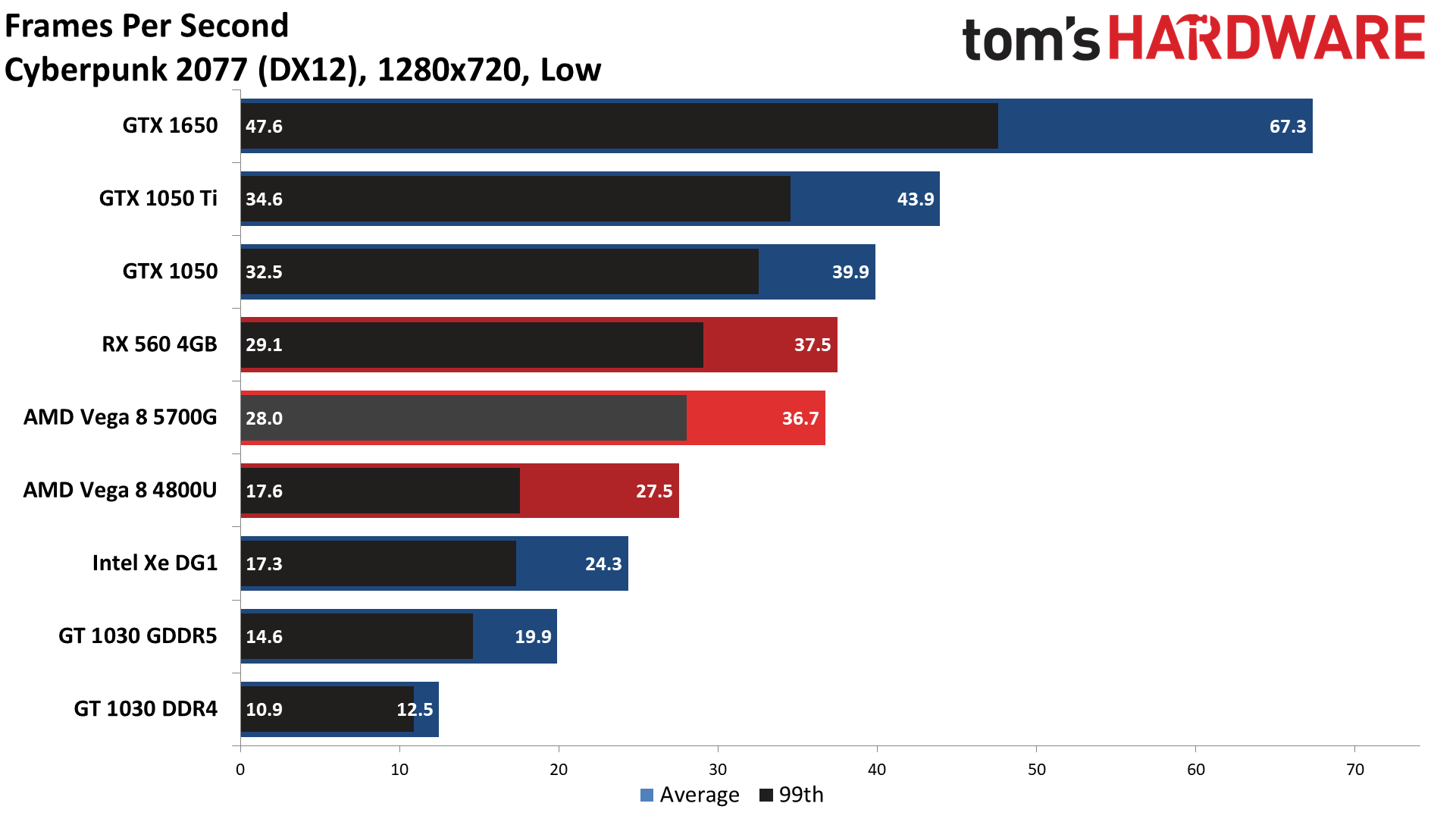









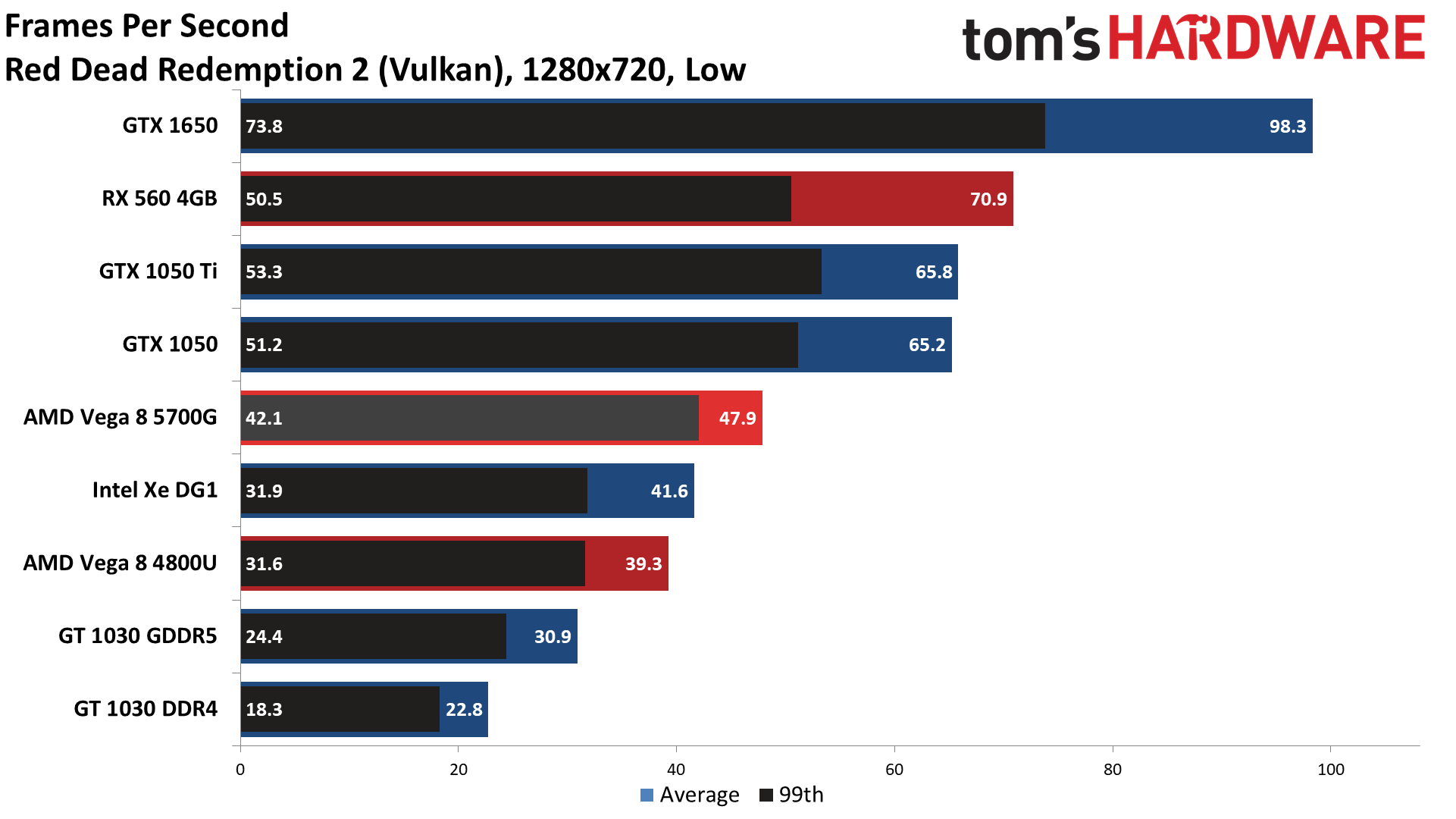


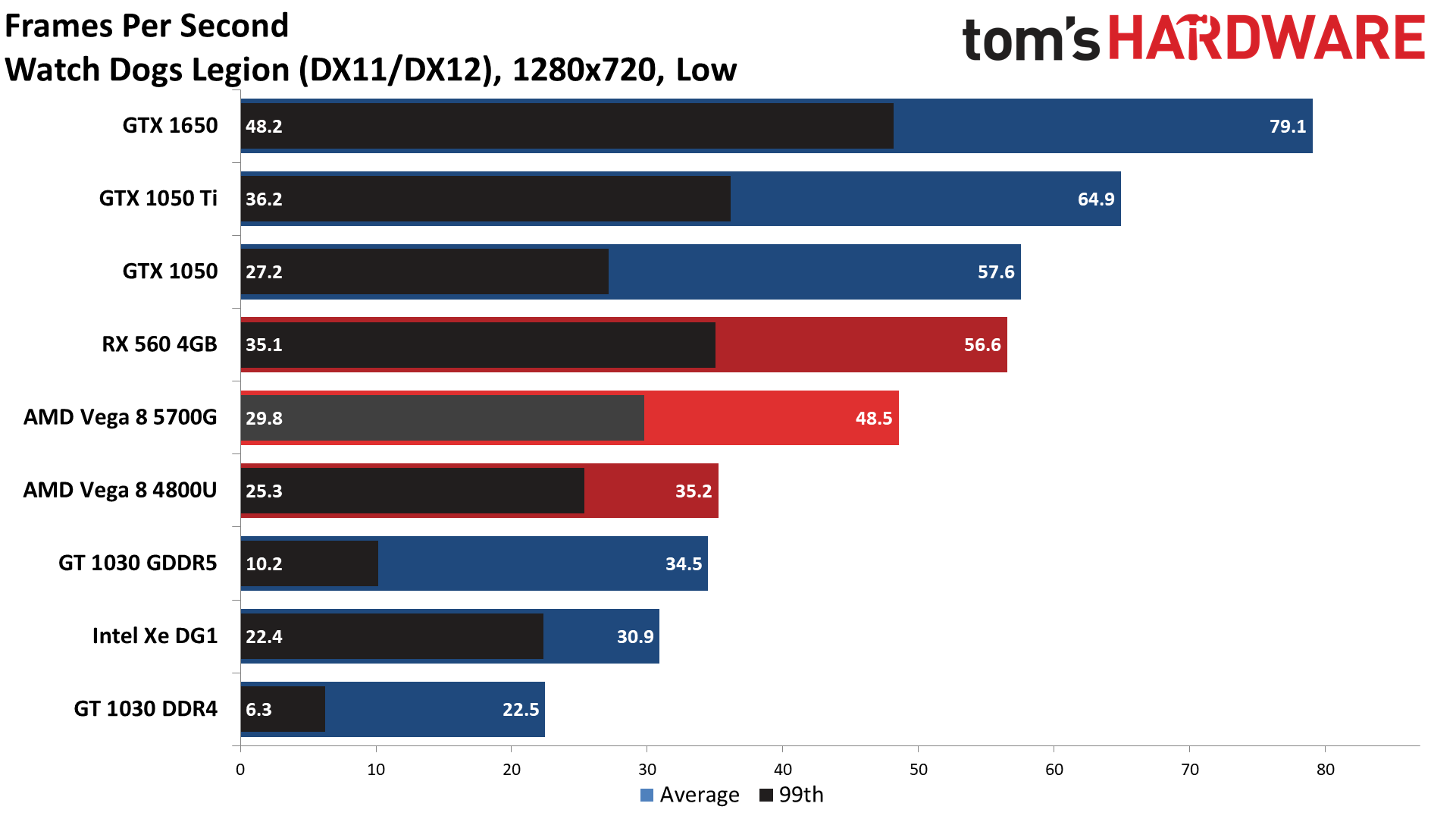




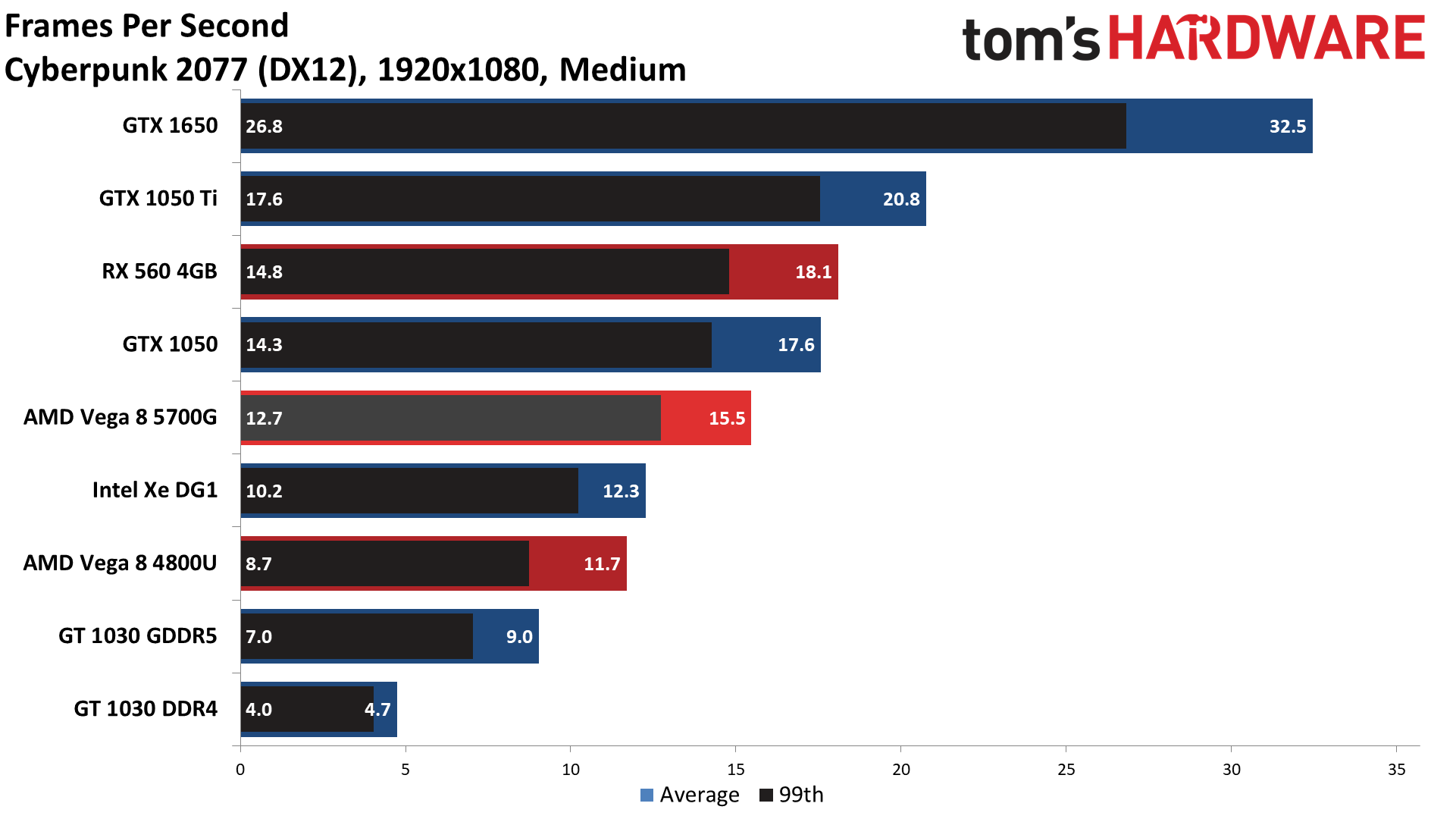













Here you can see a series of tests contributed by our GPU editor Jarred, comparing the 5700G's iGPU to the most relevant discrete GPUs along with the Ryzen 7 4800U. Jarred's extended testing shows that the Ryzen 7 5700G is the fastest integrated graphics solution currently available and that it equates to slightly better than GT 1030 levels of performance.
At 720p, across a rather demanding test suite, all things considered, the Ryzen 7 5700G was 25% faster than the GT 1030 GDDR5, and 35% faster than Intel's DG1 solution — which delivers similar performance to the Tiger Lake integrated Xe Graphics. The margin of victory shrinks to around 20% at 1080p medium, as the memory bandwidth requirements increase, and this is an area where overclocking and faster memory can help, but frankly we need DDR5 systems to really deal with the memory bottlenecks. For a deeper look at the low end of the graphics market, head to our recent Intel Xe DG1 Benchmarked: Battle of the Weakling GPUs article.
MORE: Best CPUs for Gaming
MORE: CPU Benchmarks Hierarchy
MORE: All CPUs Content
Current page: AMD Ryzen 7 5700G iGPU Gaming Benchmarks
Prev Page AMD Ryzen 7 5700G Power Consumption, Overclocking and Thermals Next Page AMD Ryzen 5 5700G Discrete GPU Gaming Performance
Paul Alcorn is the Editor-in-Chief for Tom's Hardware US. He also writes news and reviews on CPUs, storage, and enterprise hardware.
-
lazyabum Great. Integrated GPUs are being pushed for high-end graphics over the lack of Discrete GPUsReply -
hotaru251 amd had the chance to crush intel's low end if they just had more modern apu inside...let vega die already. its 2021.Reply -
AlexWolfheart Clearly the guy that wrote this piece and declared it "the fastest integrated graphics ever" has rather limited knowledge.Reply
Amd (and Intel, working together) has an old integrated Vega that's close in performance to a gtx1060, basically obliterating the 5700G:
Intel 8809G with the Radeon M GH igpu (found inside intel hades canyon nuc)
It may not be a user replaceable apu, but it IS an igpu that can easily demolish this one in terms of performance. But then again, the clickbait title wouldn't be as good as this, now, would it? :) -
Jim90 Reply
But they ARE crushing the igpu competition...and they're showing they don't need higher than this for that.hotaru251 said:amd had the chance to crush intel's low end if they just had more modern apu inside...let vega die already. its 2021.
Once the competition catches up then, and only then, will they integrate their other choices. From a business point of view this is eminently reasonable, as much as we'd all like integrated rdna2/3 now. -
AlexWolfheart ReplyJim90 said:But they ARE crushing the igpu competition...and they're showing they don't need higher than this for that.
Once the competition catches up then, and only then, will they integrate their other choices. From a business point of view this is eminently reasonable, as much as we'd all like integrated rdna2/3 now.
So, in short, they're greedy, not offering their best because of weaker competition.
If you were hoping to defend AMD, this argument did worse ... -
King_V Reply
Where did you get the performance numbers that back this? I haven't been able to find any solid reviews on this.AlexWolfheart said:Clearly the guy that wrote this piece and declared it "the fastest integrated graphics ever" has rather limited knowledge.
Amd (and Intel, working together) has an old integrated Vega that's close in performance to a gtx1060
(not looking for YouTube videos, but article reviews with charts and such) -
fball922 Reply
Companies exist to make money, and to make as much money (legally) while expending the smallest amount of money possible, so I guess that is greedy? Doing what they are supposed to do? This is literally what every market does. If you were trying to shame AMD for not putting in an iGPU in that makes you feel warm fuzzies, this argument did worse... Of course, if they had gone the route of upgrading the iGPU, then raised the price of the APU, we would probably hear moaning and groaning about how they shouldn't raise the price because it's so greedy of them.AlexWolfheart said:So, in short, they're greedy, not offering their best because of weaker competition.
If you were hoping to defend AMD, this argument did worse ... -
AlexWolfheart ReplyKing_V said:Where did you get the performance numbers that back this? I haven't been able to find any solid reviews on this.
(not looking for YouTube videos, but article reviews with charts and such)
Have you tried... Google?
I've got the performance numbers both from google, but also from actually owning a NUC8i7HVK as my bedroom media pc, but here, i'll post links for you, since it's so hard to find info:
https://www.tomshardware.com/reviews/intel-hades-canyon-nuc-vr,5536.html
https://www.gamersnexus.net/hwreviews/3282-hades-canyon-review-intel-amd-pressure-nvidia-nuc8i7hvk
https://www.notebookcheck.net/Intel-Hades-Canyon-NUC8i7HVK-i7-8809G-Radeon-RX-Vega-M-GH-Mini-PC-Review.290800.0.html
https://www.anandtech.com/show/12572/the-intel-hades-canyon-nuc8i7hvk-review-kaby-lakeg-benchmarked
As I said before: yes, it is not a user replaceable APU, but it is an integrated gpu from over 2 years ago that still mops the floor with all other igpus. -
AlexWolfheart Reply
Given amd's very low market share in terms of gpus, but decently growing cpu market share, going all in and releasing a cpu with a very powerful igpu would be a good marketing decision, to make them sell even more, and make less people buy Nvidia.fball922 said:Companies exist to make money, and to make as much money (legally) while expending the smallest amount of money possible, so I guess that is greedy? Doing what they are supposed to do? This is literally what every market does. If you were trying to shame AMD for not putting in an iGPU in that makes you feel warm fuzzies, this argument did worse... Of course, if they had gone the route of upgrading the iGPU, then raised the price of the APU, we would probably hear moaning and groaning about how they shouldn't raise the price because it's so greedy of them.
Amd could, in theory, with rdna2 integrated, like the xbox series something and ps5, it could make customers not need to buy an rtx3060 (ti or simple), and thus, keep more marketshare for themselves ;) -
greenreaper With RDNA2 coming in 2022, and prices still abnormally high, it's hard to recommend this as an APU unless you need it now or don't care about the new architecture's boosts in power/perf - or having some level of hardware raytracing support.Reply
To me, having feature parity with the latest consoles is important, because that'll help as many games work on it as possible, even if they don't work as fast. The big question for me is whether RDNA2 will work as well without the large cache in its discrete editions.
